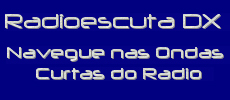
Experiments with ferrite rod loop antennas for MW
Size Does Matter !
| NAVEGUE NAS ONDAS CURTAS DO RÁDIO | ARTIGOS TÉCNICOS DX | ENVIE SEUS COMENTÁRIOS | PROCURE NESTE SÍTIO |
 |
Experiments with ferrite rod loop antennas for MW Size Does Matter ! |
Ferrite rod loop antenna for MW
by Sarmento Campos - email: sarmento.campos@sarmento.eng.br
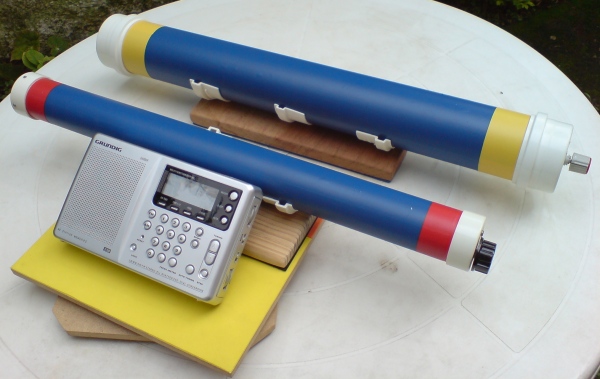
Both ferrite loops follow the same principle: a passive LC circuit but large
diameter (same lenght but bigger cross section)
The antennas useful for MW/LW reception, are ferrite rod antennas. These antennas have always a bi directional receiving behaviour like a classical dipole antenna and also, an air coil antenna.
Considering they are very easy to use, and give excellent results considering it's dimensions, it is one of my best bets for MW dxing everywhere.
This successful antenna is
based on the article “Loop Experiments: The Super Booster Bar, by Gerry Thomas”,
published on National Radio Club.
This antenna has been tested and improved for almost ten years by Rene
Gustav Passold, a Brazilian Dxer who masters ferrite loop techniques.
DX Club of Brazil has the mission to produce it and make it available for
purchase to local MW and also SW enthusiasts.
Imagine a small antenna capable of enhancing the desired signal by just coupling
it magnetically with the internal ferrite bar of a good quality portable
receiver. Just approach the loop antenna to the receiver and you now can listen
to new stations and also null the local one with some level – depending of
course of the direction of local stations and the desired signal and so on.
This antenna is well known in Brazil as RGP3 (initials of ithe name of the
pioneer and the number “3” refers to the presently version in production).
But, dxing is not only catch distant stations … It looks like a state of mind.
After some research in my old (not so old…) books related to engineering (math’s,
physics, and electromagnetism) and after proven calculations over the “original”
RGP3 antenna, including some lab measurements, I decided to try something new.
Of course, all physical laws applied, no new theory, nothing new, but I was
really decided to try new materials, new dimensions and new components.
What’s the goal to be achieved?
More gain and directivity, I mean, better nulling capacity.
A friend of mine, one of the coordinators of DXCB has sent me a very interesting
article written by Bill Bowers and John Bryan about an experiment of very large
loop antennas using ferrite.
And that was the trigger of my experiment.
According to the article, the bigger is not the better, but the rate “Dimension
x Cross section” is supposed to be the key to a balance in gain and nulling
skills of this kind of antenna. Gerry Thomas, for sure has initially tested this
behavior, as Rene Passold did more recently.
But why not make something better but really efficient, considering mechanical
assembly, portability, and practical results to achieve far away distance MW
stations?
First, I have started doubling the number of ferrite rods using same type of
wire – enameled wire – and same variable capacitor of the original RGP3. Some
cross section 40 mm and same number of rods multiplied by 2 (its axial dimension).
Doubling the “bazooka” length should by suffice for the first experiment. But
the results were disappointing. Nothing more than better null, it is a fact.
Same gain, but the practical results are the same then the original RGP3. Just
wasting time as I could checked it …
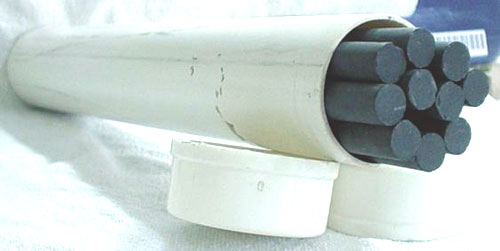
Using 40 mm pvc pipe cross section can
accomodate 10 ferrite rods (10 mm diameter each)
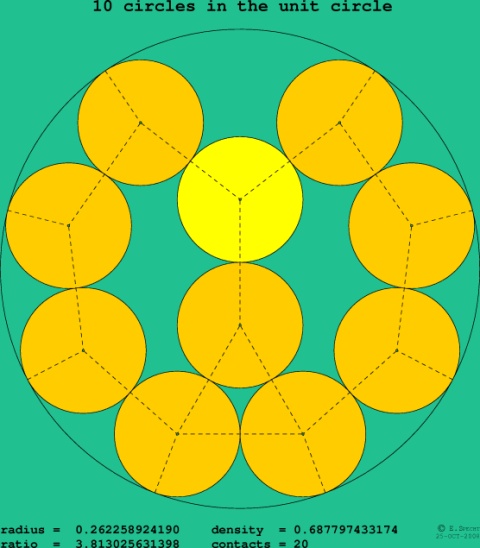
Circle calculation shows ferrite density using a perfect unit circle - Density
of 0.687 which gives certain unused space
But when I studied a bit
more the equations evolved, and also, the mechanical features of the pvc pipe, I
have came up with a very relevant issue.
And the math’s exploration has sent me to look at efficiency of “circle inside
circle”. I mean, and of the most important feature of ferrite loop antennas, in
spite of its inductance equation that points to the magnetic permeability of the
ferrite rod, are the phenomena of magnetic lines leakage travelling axially the
antenna.
Now, it the help of all tables available at
www.packomania.com that
provides not only the density of the assembly of a pcv type filled with ferrite
rods, but also provides the number of contacts of the rods itself!
And at this moment of my research, I have established a target: better gain
through better mechanical assembly, and better nulling than a regular ferrite
loop antenna.
And using commercial available pipes, I have found out that a 50 mm cross
section pipe would enhance the ferrite density by 12 %. Also, the rate “length x
cross section” would be better than the regular loop which is supposed to give
better nulling capacity. To enhance the assembly, a new variable capacitor, this
was supposed to provide better Q factor to the LC circuit. And Litz wire, aiming
the half of MW band to complete the experiment.
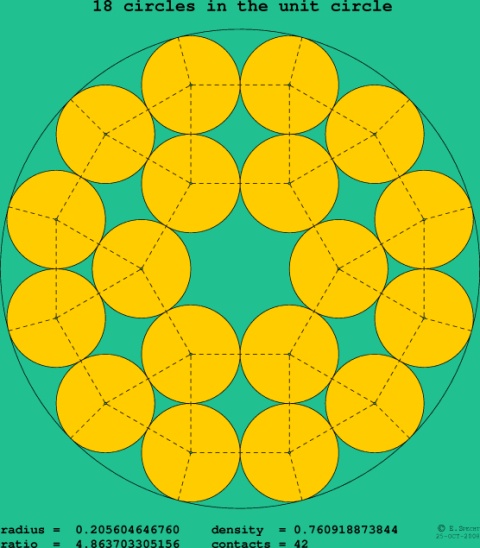
Now inside a 50 mm cross section pipe, better ferrite rod dendity : 0.760 and
more contacts
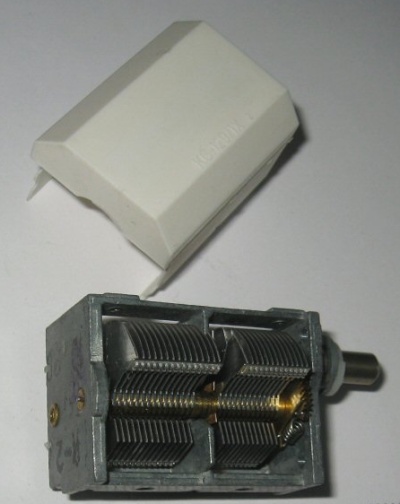
Two gang capacitor with larger capacitance range : 20 pF - 520 pF
After some calculations,
coil done, and inductance measures indicated values next to the estimated using
permeability values provided by the ferrite supplier.
All assembly ready, and let's test it out soon!
The practical results are amazing, not only more signal gain but the ability to
attenuate local power stations makes a difference. Although it is large and
heavy weight – imagine 36 ferrite rods perfectly aligned in a pipe with 2 groups
of 18 rods 10 x 200 mm – it is practical to use and keeps the portable feature
of the original “bazooka” antenna.
The gain was dramatically increased comparing to the regular RGP3 and it is easy
to excite the receiver’s front end with signals very eligible not received by
the original antenna. Even day time experimentation, proved that some
channels that up that time were quiet, now, signals from almost 450 km away
could be heard on 840 kHz (Radio Bandeirantes, Săo Paulo).
Thanks a lot to Rene Passold who has taught me a lot about ferrite loop antennas,
and to the pathfinders that made a really very large ferrite loop antenna to
show us theory and practical results.
By changing the diameter and the length of the rod, the characteristic of the reception behaviour can be influenced. A bigger diameter and a shorter length leads to a less strong bi-directional reception. This information was taken into consideration by planing the antenna assembly.
|
|
|
Better gain or better null? Why not both?
The total cost of this experience was about US$
250,00 and some months of research and assembly time and adjustments. Not to
talk about lots of different pvc pipes destroyed and my wife’s complaints about
all the mess during the hard work!
But is it really worth the time and effort?
Yes!
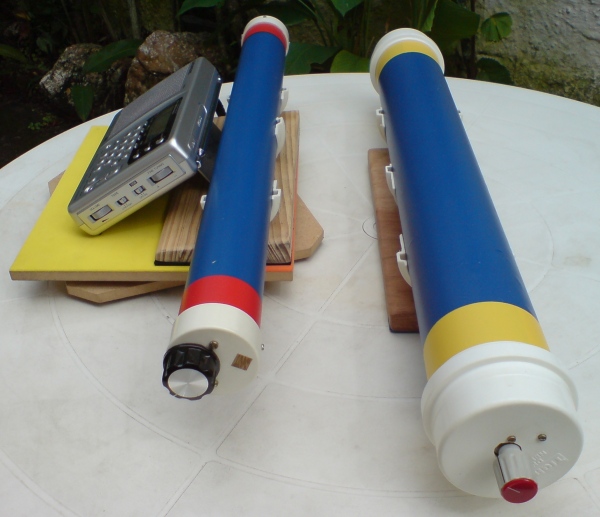
Comparing the 3 antennas, the original RGP3 and both extended loops, showed
improvements only in the larger one
Demonstration of signal increase using the monster ferrite loop antenna. Shack located in Maricá, Rio de Janeiro, Brazil, and the MW station FIRS Falklands 530 kHz could be heard loud and clear.
|
The champion ferrite loop antenna produced by DX Club of Brazil
|
|
Sources:
Rene G.
Passold - DX Clube of Brazil
www.dxclubedobrasil.com
Loop Antenna Handbook - Joe Carr
Packomania - Useful site for circle
calculations
http://www.packomania.com/
C-Maxgroup - hardware and software supplier -
http://www.c-maxgroup.com/home/index.php
Bill Bowers and Joh Bryabt - Very Large Ferrite
Loops
The ARRL Antenna Book
|
Sitio dedicado ao Rádio
de Ondas Curtas e a prática DX -
Navegue nas Ondas Curtas do Rádio |
Acessos desde 2002